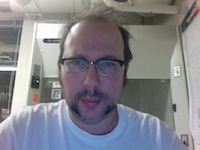
This is what four days in lab looks like.
It is 7:24 on the day before Thanksgiving. AC/DC is cranked up so loud my ears are starting to bleed and I have at least four more hours to go before I go home tonight. There are papers and three lab notebooks strewn all over my bench top. This is my fourth 18-hour day in a row. A crazy look in my eyes and a five-day growth on my face. A marathon set of experiments trying to decipher the growth curve of the community of deep earth microbes that I am trying to identify and characterize.
I started this morning over thirteen hours ago by coming in, turning on the gas to exchange the atmosphere in the anaerobic tent loading chamber, and promptly blowing out the seals in the CO2 regulator. You know that when this happens at 6:30 in the morning, it is not going to be a good day. I couldn’t find another one in the building (nor in friends labs in a couple of other buildings) so I settled in and waited until AirGas opened later that morning. Needless to say, it was closer to 1:00 in the afternoon before I got the tent back operational, putting me at least five hours behind schedule for an already jam packed day. So this is how I find myself with one more hour to wait while my microbial cells sit in the first incubation of many in a long protocol with which I will fix them in paraformaldehyde for later DAPI stain and FISH analysis.
Why do I do this? Why do I put in the long hours crazy hours? Because I love it. Plain and simple, that is the only answer I can give. I delve into the unseen, the unreal, the unknown world of extreme microbes, and try to make it visible, real, solving the mystery of who lives where and how the hell they do what they do in those most inhospitable places in which they thrive. I have to design an experiment with the full understanding that the equipment does not exist for me to do these experiments. I cannot go to a shelf and just pick up one of these and three of those and have some technician come over and set it all up for me. This is truly science driven by your capacity to design, invent, and assemble the equipment that you will need, while doing the experiments at the same time.
Sometimes I forget how incredibly crazy and out of this world what I do is. I get reminded of this when I try to explain what it is that I do to friends and family. I get this look of fear and awe when I explain that the things I study grow at 100-200 atmospheres, at temperatures between 50-75 degreed centigrade, and under acidic conditions so extreme it would peel the skin off your bones. Like I said, this is pretty cool stuff.
Well, I got to go now, the next cell wash and incubation is about to begin. While all this is extremely exciting, getting to that final answer is laborious, painstaking, and tedious. Still, I would not trade this life for any other one. This is what I am thankful for on this week. I get to do what I love (and sometimes get a little frustrated at) every day. Take care and have a great Thanksgiving.









